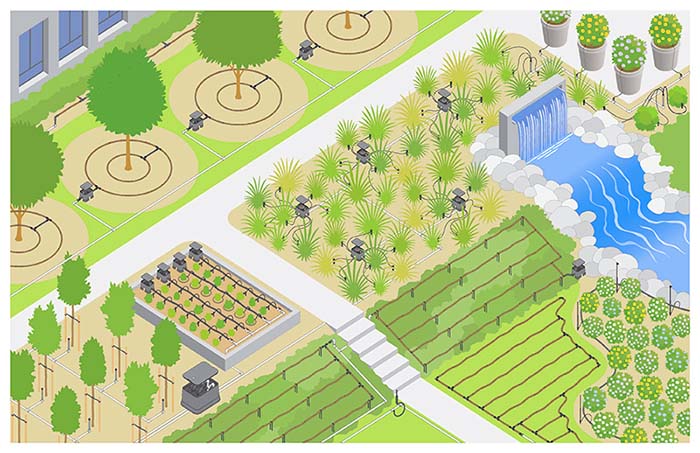
Our Catalog Continues to Grow! Check back often.
Single Product

The Basics of an Irrigation System
in Jain IrrigationThe Basics of an Irrigation System
By; Michael Derewenko 12/10/2018
Controllers
The controller sometimes referred to as a “timer,” is simply an interface to interact with the scheduling of your irrigation system. What can cause confusion for some users is the terminology associated with zones or stations. To clarify we refer to “zones” at a controller level as “stations.” “Hydrozones” refer to an area of your landscape that require similar watering methods and demands. To simplify what was once a complex series of event programming manufacturers have numbered stations and added scheduling options like, Start Times, Station Run Times and Days of the Week to water.
On a non-smart controller, a start time is selected to begin a cycle of stations. For example, a start time of 8 am will start a cycle that will run through each of the stations on that given program. How long that cycle takes to run through is dependent on each Stations Run Time. 4 stations running at 20mins each will produce a cycle that will run from 8 am until 9:20. Once users feel more comfortable, they tend to get a little more daring and start running schedules at night and in the morning to break up cycles.
On smart irrigation controllers like GreenIQ and ETwater, users will input landscape information by station (soil type, slope, emission device, root depth, etc.) and set a Water Window. A Water Window will have a beginning time and end time which the controller will view as an acceptable time to irrigate. Thus the term set it and forget it!
Drip Irrigation
Moving our irrigation emission device closer to our root base and below ground cover allows us to water anytime we want. Water authorities don’t have watering restrictions on when you can and cannot irrigate with drip. This helps larger properties that have water windows infringing on daytime hours irrigate to their entirety. As an example, a large HOA has sports fields that are not the same system as the common grounds. Large turf areas require rotors which can take up to 3 minutes to make a full rotation, this extends water windows and can leave fields wet during the day when people want to use them. If the common areas are irrigated with drip irrigation, then the fields can take night time priority while the drip zones can run into the morning and after sun up.
A lot of people admit to having issues with drip irrigation “clogging”, “never know if its working” and “constantly having to adjust drip bubblers”. I admit at one time I too was a skeptic of drip irrigation…obviously before my current stint at JAIN.
Clogging is an easy fix. Usually, drip systems are retrofitted from existing spray and rotor systems and the proper filters, and pressure regulators are not installed on the valves. Heads are removed, and drip line is attached, and away we go, but not for long. When retrofitting or installing Emitterline or emission devices with small orifices the installation of these few devices can make your drip system maintenance free: filter, pressure regulator and automatic flush valve.
Pressure Regulation
I’ve mentioned the term pressure regulation a couple of times now, and you’re probably wondering what this means or the importance. Like anything manufactured there is an ideal way and time to use a particular device. All irrigation manufacturers operate under similar system variables, and operating pressure is one of them. Sorry irrigation industry the secret is out!
Drip systems only need a small amount of energy to move water through the lines because we’re not firing water through the air with a range of environmental conditions changing throughout the day. Our delivery environment is consistent and enclosed in tubing, to ensure we have the force behind the water we are moving we use a pressure regulator to keep pressure within manufacturing operating pressures (20psi for drip, 40psi for sprays). 20 psi will provide enough pressure to move water but not too much that debris is jammed into our emitters and emission devices.
Traditional pop-up spray heads and rotors need more pressure to elevate water to the perimeter of the heads radius, spray heads like to see 40psi and larger rotor zones could even stand to have upwards of 50psi.
Irrigation FAQs
Does a leak indicate that a sprinkler is broken?
In most cases, no. Many irrigation systems have the excess water drain through the lowest head in the pipe until the water is empty, so short-term seepage from a sprinkler head is not always a good indicator that it is broken or needs to be replaced.
How long does irrigation take to install?
Irrigation can typically be installed in less than a week, but ideally, the installation can take as little as two days with good weather.
Contact us today to place an order.







